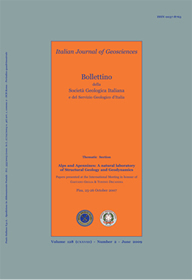
Evidence of syn-sedimentary tectonic activity in the «flysch di Ventimiglia» (Ligurian Alps foredeep basin)
Stani Giammarino(*), Stefano Orezzi(*), Michele Piazza(*) & Davide Rosti(*)
(*) DIP.TE.RIS. - Università degli Studi di Genova - Corso Europa, 26 - 16132 Genova, Italy. 0103538286 - mpiazza@dipteris.unige.it.
Volume: 128 (2009) f.2
Pages: 467-472
Abstract
In the study area, located between Argentina Valley and Roya Valley, south of the village of Triora, the Meso-Cenozoic cover of the Argentera-Mercantour Crystalline Massif consists of marls and marly-clays, Campanian in age, that are overlain by the Paleogene unit named «Nummulitique».
This unit is composed of a transgressive upper Lutetian complex evolving into a Bartonian-Priabonian siliciclastic turbidite complex («Ventimiglia flysch»). The lower complex includes coarse grained siliciclastic, mixed and carbonate lithofacies of shallow marine environments (Capo Mortola calcarenite) grading upwards to deep marine marls (Olivetta San Michele silty marl). In the area, the nummulitic limestone is commonly made up of larger foraminifera-bearing calcarenite and calcirudite that, from South to North, laterally grade to oncolithic limestone (Loreto calcarenite member), mainly composed of rhodoliths and Acervulina macroids.
The Ventimiglia flysch can be regarded as a lateral equivalent of the «Grès d'Annot». The sedimentation of the lower and the upper complex is controlled by the tectonic events of the Ligurian Alps. The former deposits took place during the early evolution stage of the Ligurian Alps foredeep basin, whereas the turbidite deposits of Ventimiglia flysch record the basin filling phase. Evidences of this tectonic control are provided by the occurrence in the Ventimiglia flysch of olistoliths and olistostromes supplied by the chain front, and of slumping and synsedimentary folding.
Keywords
Get Full Text